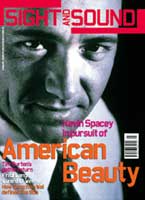Primary navigation

UK/Germany 1999
Reviewed by Xan Brooks
Our synopses give away the plot in full, including surprise twists.
Leicester, the present. Expelled from home, fantasist Frank alights at a dreary B&B run by Len, who has two sons: nerdish Kenny and wheelchair-bound Keith, who was brain-damaged in a fight with a London hardman named Donut. Believing Frank's claim that he once served in the SAS, Kenny pays him 500 to avenge Keith's injury by killing Donut.
Frank steals a gun and he and Kenny take a coach to London. After a day's sightseeing, they travel to Donut's flat. Donut is out, so Frank and Kenny hold his girlfriend Jackie hostage while they await his return. Jackie attempts to reason with her captoras and then to seduce Frank. When night falls, the group are disturbed by Moose, a pizza-delivery boy who is also taken hostage. While arguing with Moose, Frank lets slip he was never in the SAS. Kenny forgives him but Frank is inconsolable. Jackie's neighbour Graham tries to effect a rescue and in the ensuing chaos Moose escapes. Frank panics and shoots himself in the leg before knocking Graham unconscious. Frank and Kenny flee the flat just before Donut arrives back. The two friends catch the coach home.
Adapted by Paul Tucker from his original stageplay, The Last Yellow betrays its greasepaint origins from start to finish. Essentially this Midnight Cowboyesque tale of two simple souls adrift in the big, bad city sticks like a limpet to its two-act structure. Act one is set in Leicester, act two in a London high-rise; in the middle comes a relatively fluid intermission showing the protagonists touring London's tourist sights, a cinematic concession which only highlights how stiffly structured the rest of the picture is.
The Last Yellow takes its lead from kitchen-sink theatre and the Only Fools and Horses school of blue-collar television sitcoms (debut director Julian Farino cut his teeth directing episodes of Out of the Blue and Coronation Street). Its narrative is simple, almost threadbare, its characters little more than genial archetypes. Mark Addy's overweight anti-hero wears a Hawaiian shirt and a shaggy mullet (badge of the self-deluded). For his role as the gormless Kenny, Charlie Creed-Miles seems to have been studying both Tim Roth's classic geek interpretation from Mike Leigh's Meantime and the wardrobe of Blur guitarist Graham Coxon. His character shuffles about with thick NHS specs perched above a dopey half-smile and says things like: "Egg sandwiches are my favourite. I'm egg mad, I am."
Fortunately, nestled amid The Last Yellow's neat and familiar furniture there's one lone agent of chaos: as Jackie, the hostage girlfriend of the thuggish Donut, Samantha Morton fairly crackles with vibrant, unstable energy. To be fair, Tucker helps her out here. The dialogue for Jackie proves as economic as Frank and Kenny's is long-winded. It sketches her in subtly, and Morton's charged performance does the rest. Jackie emerges as simultaneously victim and villainess, vulnerable and dangerous, a rogue element that could go either way.